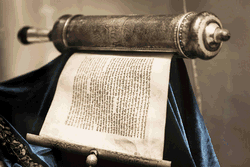Judaism is often seen as a religion more concerned with the practicalities of everyday life than with esoteric teachings or mystical flights. Most Jewish teachings do, indeed, focus on doing your best to follow God’s will while here on earth (rather than devoting time and energy to unraveling the mysteries of the divine). Judaism does, however, have a deeply rooted mystical tradition known as Kabbalah.
Kabbalah is a school of thought which seeks to answer the most basic questions about life: Why are you here? What is the purpose of life? What is the nature of God? What is reality? Kabbalah is also a method of studying the Torah with the aim of breaking through the direct, literal meaning of the text to its inner, hidden message. The Torah is the central, spiritual scripture of Judaism.
 The Torah, sometimes called the ‘five books of Moses’, is said to have been given by God through Moses to the Jewish people. Some of the content is said to have been present at Mount Sinai, when Moses sought God’s guidance and returned with the 10 commandments. Part of the Torah is said to be the teachings of Moses at the Tabernacle. All the teachings were written down by Moses, which resulted in the Torah we have today. The term ‘Torah’ can be translated as ‘instruction’ and, on the whole, the Torah provides ‘the rules’. It explains how a person is to live in order to remain to remain in God’s good graces. The Torah also contains some of the history and trials of the Jewish people.
The Torah, sometimes called the ‘five books of Moses’, is said to have been given by God through Moses to the Jewish people. Some of the content is said to have been present at Mount Sinai, when Moses sought God’s guidance and returned with the 10 commandments. Part of the Torah is said to be the teachings of Moses at the Tabernacle. All the teachings were written down by Moses, which resulted in the Torah we have today. The term ‘Torah’ can be translated as ‘instruction’ and, on the whole, the Torah provides ‘the rules’. It explains how a person is to live in order to remain to remain in God’s good graces. The Torah also contains some of the history and trials of the Jewish people.
Kabbalah is about understanding the Torah not just literally, but also discovering the spiritual underpinning of the words. One might compare it to the two schools of thought about the Bible – on the one side are those who feel that the Bible needs to be understood (and followed) only literally. Then, there are those who seek to understand the Bible more spiritually, to discover what is beneath the words. Just as with Christians who do not agree that there needs to be a ‘spiritual interpretation of the Bible’, in Judaism, not all Jews see the Kabbalah as necessary to Judaism.
The main teaching of Kabbalah is the idea that God has two aspects. One aspect is the transcendental – God in beyond this material world and cannot be defined by the world. The other aspect is immanent – that God dwells within all there is both in this material world and beyond. The absolutely transcendental nature of God (known as Ein Sof) is completely limitless and infinite and not bound by time and space. The imminent nature of God, on the other hand, contains the attributes of God which enter into this material universe in order to sustain it. Kabbalah devotes itself to the study of God’s manifestations within this world, but maintains that God’s Ein Sof nature is completely beyond human understanding.
A Brief History of Kabbalah
Tradition holds that the methods and teachings of Kabbalah were first revealed by God to Adam in the garden of Eden. This knowledge was then passed down through the generations and, by the 10th century BC, practiced all throughout Israel. After a series of foreign conquests, the story goes, the knowledge of Kabbalah was driven underground in order to keep it from falling into the wrong hands. Kabbalah would not re-emerge again until the Middle Ages (between the fall of Rome around 476 AD and the beginning of the Renaissance in the 14th century).
Most traditional scholars are of the opinion that history of Kabbalah (as claimed by modern Kabbalists) is either unverifiable, or, likely not accurate at all. Though scholars agree that there did exist early forms of Jewish mysticism, many researchers nevertheless hold that the methods and teachings of what we know as Kabbalah can only be traced to as early as the 12th century AD. It then gained considerable popularly in the 13th century AD with the publication of a text known as the Zohar.
Kabbalah and the Zohar
The Zohar is a work of such importance in the Kabbalistic tradition that it has often been identified with Kabbalah itself. It was published by a Kabbalist writer named Moses de Leon. Leon claimed that the content of the Zohar was originally written by a rabbi named Shimon Bar Yochai in the 2nd century AD. Most of what is known about Shimon Bar Yochai is shrouded in legend. Yochai was considered an ascetic, miracle worker and teacher. Again, most scholars dispute the Zohar could have come from the second century AD or Yochai – and again – most Kabbalists are unconcerned with confirming historical accuracy and are more concerned with understanding the spiritual insights provided by the Zohar.
The pages of the Zohar contain mystical commentaries on the Torah which are intended to lead people to a greater understanding of God and of their own souls. It also discusses topics such as sin, redemption, the creation of the universe, the structure of the universe, mysticism, psychology, energy, and humanity’s place within the cosmos.
The early Kabbalists during the Middle Ages, and on through the Renaissance, performed their studies and practices covertly. And, they were not just those of Jewish heritage. Early Kabbalists were also alchemists, scientists, nobility and even Christians (who found attachment through the Bible’s Old Testament). Fear of the Inquisition kept the Kabbalists underground and it is rumored that a number of other secret organizations such as the Freemasons, the Illuminati, the Knights Templar were influenced by Kabbalah.
There has always been a magical aspect to Kabbalah, in fact, during the middle ages Kabbalist were thought of as ritual magicians. There are spiritual rituals, mathematical applications to the ‘tree of life’; contacting angels and commanding Demons; knowing the secret names of things in order to control those things; a secret ‘code’ within the Torah which conveys power those who discover it; understanding the power conveyed to those who understand important symbols – all this mystical, magical, occult flavor to the Kabbalah has kept it moving forward for centuries.One might be tempted to think of the Kabbalists as just plain deluded until one studies some of it’s older spiritual teachings. For example, older Latin kabbalistic text from the Middle Ages explain how the properties of spirit and body (energy and matter) are really the same thing – and suddenly it looks like Einstein’s theory of relativity explained from a spiritual perspective.
The Kabbalah wouldn’t really ‘come out of the closet’ until Aleister Crowley and his occult group the Golden Dawn began to introduce Kabbalah to the general public in the early 20th century. Crowley first began to introduce Kabbalistic concepts through his own secret organization, then later through his books and public discussions. Though Kabbalah had been born within Judaism, by the end of World War II, it was embraced by many people from many different cultures and religious backgrounds around the globe.
Kabbalah Outside of Judaism
As noted, Kabbalah has intrigued spiritual seekers from outside of the Jewish tradition ever since its inception. For example, Kabbalah texts such as the Zohar were used extensively by certain Christian traditions during the renaissance. This lead to the formation of syncretic movements such as Christian Kabbalah.
More recently, Kabbalah has found a second home within New Age circles. Its teachings about the nature of God and the soul are seen by many as a natural complement to the Eastern wisdom (which has also been eagerly adopted by the New Age). Kabbalah has further received a significant boost in popularly with a number of celebrities, both past and present, who have become interested in Kabbalistic practices and teachings. This includes people like Madonna, Demi Moore, Paris Hilton, Gwyneth Paltrow, Elizabeth Taylor, Jerry Hall, Winona Ryder, Jeff Goldblum, Courtney Love, Roseanne Barr and many others
Today, it would seem, the modern spiritual seeker is less receptive to strict religious tenants and literal scriptural interpretation. Contemporary thinkers and seekers seem more interested in the mystical, inner way of relating to the divine. This lack of contentment with traditional religions has lead to the rise of interest in (and appreciation for) the Kabbalah and other mystical, less dogmatic forms of spirituality.Even though Kabbalah has found appreciation in modern times, it is still view by traditional Christians and Jews as ‘occult’ and as such should be avoided. Today’s Kabbalists, as those in the past, often find themselves cast as ‘cult members’ and ostracized (which seems to happen to any group that peruses alternative forms of spirituality). Nevertheless, Kabbalah continues to find open minds, and, if it’s rich history is any indication, will continue forward for a long time to come.
Would you like to talk with someone who has an appreciation for Kabbalah? Give Psychic Joseph a call at 1-866-407-7164 (toll free US and Canada). Joseph is a professional clairvoyant and divination specialist with experience working with Kabbalah. Also, check out Live Kabbalah Chat for professional readers and Kabbalah experts.
Interesting Resources …


